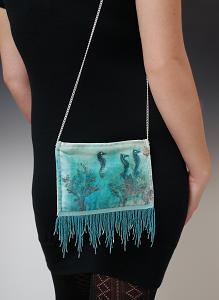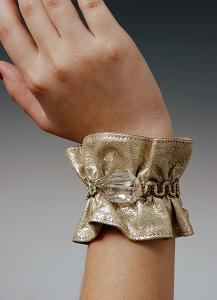
The idea of marketing via a pretty smile goes back to the beginnings of commerce. I bet that by the Middle Ages craftspeople were already using a good-looking son or daughter to sell their wares on market day!
Today, craftspeople—especially fabric artists and jewelers—want to use models in their crafts photography. Certainly, a model wearing a scarf is more interesting than a photo of the scarf lying on a table. However, there are lots of pitfalls when photographing models.
Who Is the Star of Your Photo?
Advertising agencies know that beautiful eyes, perfect skin, and a pretty smile are guaranteed to distract the viewer from an otherwise boring image of the product. A great example is the TV spot with the actress Charlize Theron. After running past a digitally included Marilyn Monroe and other stars, Ms. Theron appears in a gold dress that clings tightly to her body. It is a visually stunning ad, but I had to use the Internet to find out what she was peddling. It was Dior J’Adore perfume. Charlize Theron’s ad is an extreme example of how beauty sells and how it can overwhelm the product. You don’t want that to happen when your handcrafted creation is meant to be the star.
Shattering the Beauty Myth
Lots of models look very ordinary in real life. They come into the studio in faded jeans and T-shirts, and it takes a team of makeup artists, hairdressers, and stylists to prepare them for photography. However, even then their looks are deceiving. The most important quality of a good model is how the camera loves them. The lens changes the way a model looks. It reshapes their face; and when it does, the result is magical.
So let’s call this Rule #1: If you are going to use a model, take photos first to see how the model looks in photographs.
Sometimes I’ve had to find the right model for a shoot by trial and error, once spending several days photographing dozens of models for a magazine fashion spread. I photographed each one and worked with the art director and editor to make the final selection.

Coaxing Model Behavior
There is more to a good model than just good looks. The best models are very aware of how they look. They are part actor and part dancer. They know how to project feelings and sensibilities through their faces and bodies. Working with a model who knows how to move makes my work a lot easier.
Amateur models generally don’t know how they look to other people. They are pretty and they think that is enough. The result is phony posing, usually copying things they’ve seen on TV. They pout and you have to struggle to make them stop. (It seems that for many young people a “pout” is the one-size-fits-all expression, and that pout reminds me of a vampire’s smile in Twilight.)
Working with a model is a collaboration—that means I have a model draw on her experience and suggest poses I might not have thought of myself.
For jury submission photos, a model’s face can be a distraction from the craftwork. It is natural for people to look into each other’s eyes before seeing anything else. With a juror going through hundreds of images, anything that takes their eyes from your craftwork is a problem. To avoid this, when possible, frame the image by cropping out the model’s face from at least eye level. If done carefully, the image can look surprisingly natural.
Yes, photographing craftwork with a model is harder than photographing it as a still life, but done properly it is worth the extra time and effort.

Looking Great in the Great Outdoors
Working with a model requires a big space and a lot of light, particularly when you are doing a whole body-shot photographing clothing. Since most craftspeople don’t have this kind of space, an obvious alternative is to go outdoors. While there’s a whole world of locations just outside your door, you need to take the time and make test photos before shooting anything serious. I never use my backyard or lawn, because I want a location to fit the subject. I will walk or drive around looking at various possible sites and then snap a few photos to get a sense of how the space will photograph.
What I look for in a space is something that won’t overwhelm the model or the clothing. Whether it is an urban space or a forest, it needs to be anonymous. Recognizable locations start people thinking about the place and not the work. And you need to avoid making the background the subject of the photo—you can do that by throwing it somewhat out of focus.
In the full-length photo of the model shown here, I found a place where the green grass and sky would showcase the violet and blues of her skirt.






